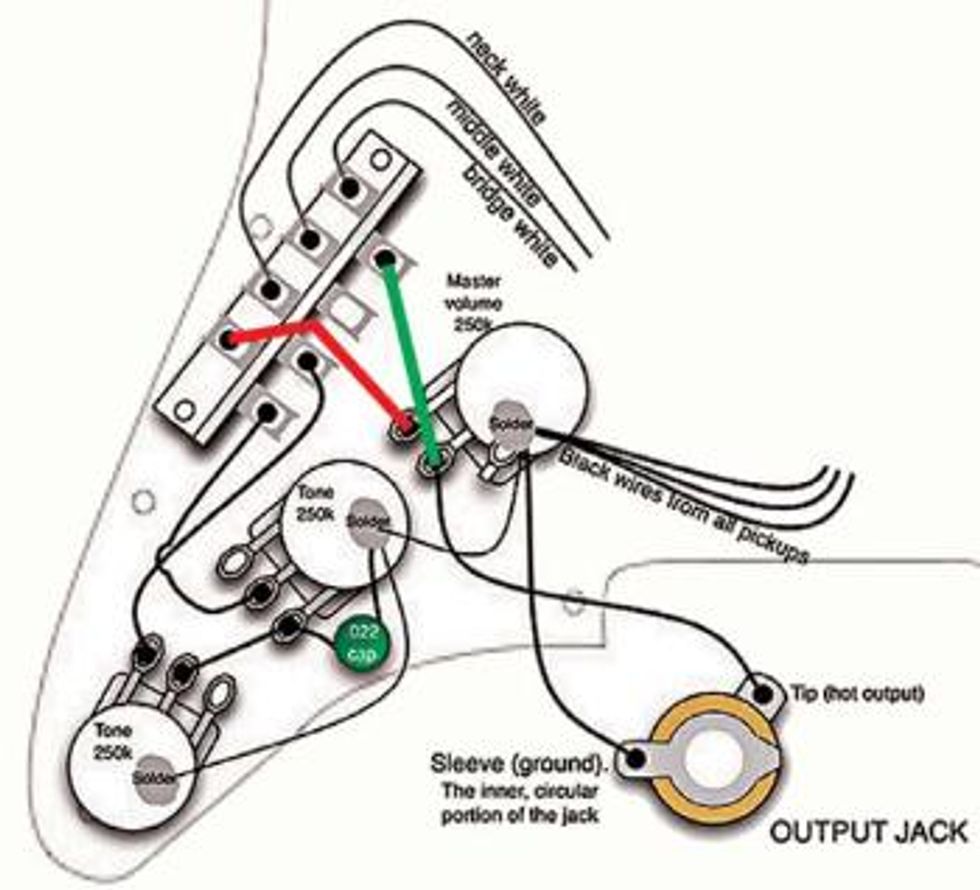Hello and welcome back to “Mod Garage." This month you find a PG first here—as far as I know, this mod was never published anywhere else before, so we'll step into new territory today: using the famous Gibson '50s wiring on a Stratocaster!
The Gibson '50s wiring is sometimes also called “Vintage Wiring" or even “'50s Vintage Wiring," but it all means the same: the way Gibson wired up their electric guitars in the late 1950s, including the “Burst" Les Paul guitars as well as the SGs and 335s. It has been a hot topic on the forums in recent years, and there have been many myths and stories about this wiring method. It was forgotten for a very long time, but today it seems to be more popular than ever.
 DISCLAIMER: Wiring diagram courtesy of Seymour Duncan Pickups and used by permission. Seymour Duncan and the stylized S are registered trademarks of Seymour Duncan Pickups, with which Premier Guitar magazine is not affiliated. |
Electronically, there's nothing too out of the ordinary about this wiring; it simply connects the tone pot to the output of the volume pot (middle lug) instead of the input. All the late-fifties Gibson guitars were wired this way, but you can do this with every guitar—and this month we'll do it with our Strats. So what's the big deal, you ask? The '50s wiring will have two major effects on your tone:
First, the overall tone gets stronger and more transparent. It's difficult to describe, but perhaps saying it's more “in your face" would be a good way to describe it. Second, the typical treble loss that occurs when rolling back the volume is much less, and both the volume and tone controls react more smoothly and more evenly, without the typical hot spots. As a side effect, it's easier to clean up an overdriven amp by simply rolling back the volume on your guitar a bit. As always this is a matter of choice, but it's definitely worth a try. It's easy to do, requires no cosmetic changes, and it's easy to switch back to the standard wiring. We'll talk about this wiring again when we switch over to Les Paul and Telecaster mods.
So, before we heat up the soldering iron, let's have a closer look at the tonal effect of the '50s wiring. I'm sure you've heard about the magical tone of the late-fifties Burst Les Paul guitars; we all know this tone from our old records. Part of the magic is the '50s wiring, which makes the tone very transparent and more “direct." The guitar responds much better this way. Without this wiring, it's difficult to get the same bloom, meaning the notes open up after they've “left" the guitar. It's always difficult to describe such tonal flavors, so I suggest you give it a try and to see for youself if you love it or not.
The other effect has to with a problem we all know from our passive volume controls—the idiosyncrasy inherent in passive single-coil pickup systems like the Stratocaster: when you turn down the volume (even just a bit), the high end or treble loss is disproportionate. In other words, a small cut in volume creates a far greater loss in your guitar's treble response. You can get rid of this problem by installing a so-called treble bleed network—a combination of a capacitor and a resistor in parallel or in series—on your volume pots, but maybe the '50s wiring will make this unnecessary for you. This wiring will greatly decrease the treble loss compared to the standard wiring.
Let's get started
If you haven't done it yet, printing out the standard Stratocaster wiring diagram and placing it on your workbench is always a good start. This makes it easier to see and understand the differences in the modded schematics. You can download the standard wiring scheme directly from the Seymour Duncan website.
As you can see, we're only swapping two wires, marked red and green, and cutting the jumper wire normally connecting the two stages of our 5-way pickup selector switch. Remember, there's a jumper wire running from lug “A" of stage 1 to lug “A" of stage 2 on the switch, connecting both stages. This allows each pickup signal to exit from the same lug and connect to the volume pot. We do not want it for this mod, so it's important to cut this connection.
That's it! I hope you have fun experimenting with this wiring method. I know some serious professional guitarists who use the '50s wiring method in all of their guitars, so it should be worth a try for everyone. Stay tuned for more Strat mods coming next month. Until then, keep on modding!
Dirk Wacker
Dirk Wacker lives in Germany and has been addicted to all kinds of guitars since the age of five. He is fascinated by anything that has something to do with old Fender guitars and amps. In his spare time he plays country, rockabilly, surf and Nashville styles in two bands, works part-time as a studio musician for a local studio and writes for several guitar mags. He is also a confessing hardcore DIY guy for guitars, amps and stompboxes, and runs an extensive webpage (singlecoil.com) about these things.







![Rig Rundown: Russian Circles’ Mike Sullivan [2025]](https://www.premierguitar.com/media-library/youtube.jpg?id=62303631&width=1245&height=700&quality=70&coordinates=0%2C0%2C0%2C0)

















